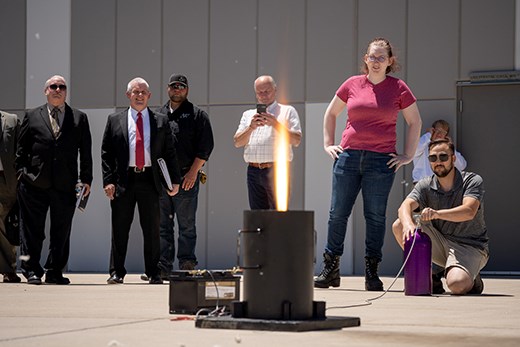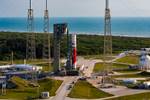Weber State students showcase composite rocket nozzle studies
Engineering students welcomed U.S. Space Command official Thomas A. Lockhart in June to demonstrate their role at WSU’s MARS in conducting real-world materials and additive manufacturing projects.

Photo Credit: Weber State University (WSU)
Back in June 2023, Weber State University (WSU, Ogden, Utah) engineering students demonstrated the progress of their senior capstone project to U.S. Space Command official Thomas A. Lockhart as he toured WSU’s Miller Advanced Research & Solutions Center (MARS). MARS was opened in August 2022 as a way to brings together students, faculty, university partners and the community to address the production deficiency in high-temperature materials deployment in the aerospace and defense industries.
Lockhart is a member of the senior executive service and the director of the Capability and Resource Integration Directorate at Peterson Space Force Base, in Colo., U.S. As part of his visit, Lockhart learned about the MARS Center’s ongoing materials and additive manufacturing projects with local aerospace partners, and proposed layout changes to the facility that will accommodate additional high-tech equipment.
To showcase the real-world studies conducted at MARS, WSU graduates joined mechanical engineering professors Dustin Birch and Spencer Peterson and current students to test the heat tolerance of a carbon fiber composite rocket nozzle under extremely high temperatures.
The team says they’re testing materials and technologies never before used for rocket nozzles. Ren Fisher, who works as a research engineer and served as project manager for the capstone project, says their research can ultimately help cut time, labor and cost for organizations working with rockets.
“Our testing platform makes it easy for us to try out different combinations, and collect data about how they perform, so future projects can trust that their rocket is the best it can be,” Fisher adds.
Like WSU, other universities around the world are contributing to new developments in the composites industry. Recent examples include the University of Sydney (Australia) where a novel recycling method is being developed for composites waste; University of British Columbia engineers successfully developed carbon fiber from bitumen; the University of Rhode Island installed an Orbital Composites AM system for advanced research in underwater unmanned vehicles; and the University of Southampton (U.K.) is advancing sensors.
Related Content
-
MATECH C/ZrOC composite is deployed in hypersonic aeroshells
Ultra high-temperature insulating CMC targets hypersonics, space heat shields and other demanding applications, tested up to 2760°C under extreme stagnation pressures.
-
Farnborough Airshow 2024 brings together aerospace innovation, collaboration
The week-long international airshow provided a hub for new announcements made by Boom Supersonic, Airbus, Boeing, GKN, GE, ZeroAvia, Eve, Bell, VoltAero, Eve and Lilium. CW has compiled several below.
-
Large-format 3D printing enables toolless, rapid production for AUVs
Dive Technologies started by 3D printing prototypes of its composite autonomous underwater vehicles, but AM became the solution for customizable, toolless production.
















